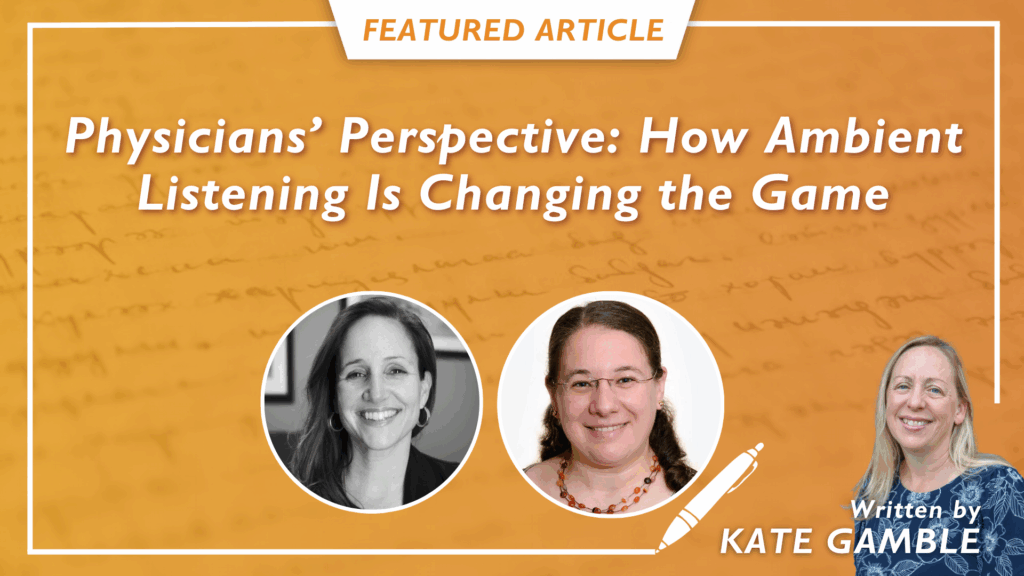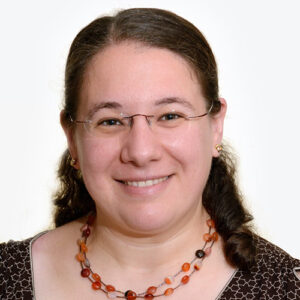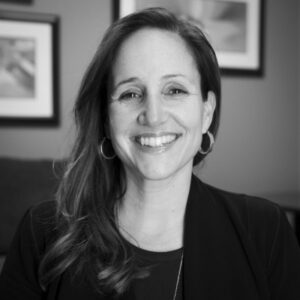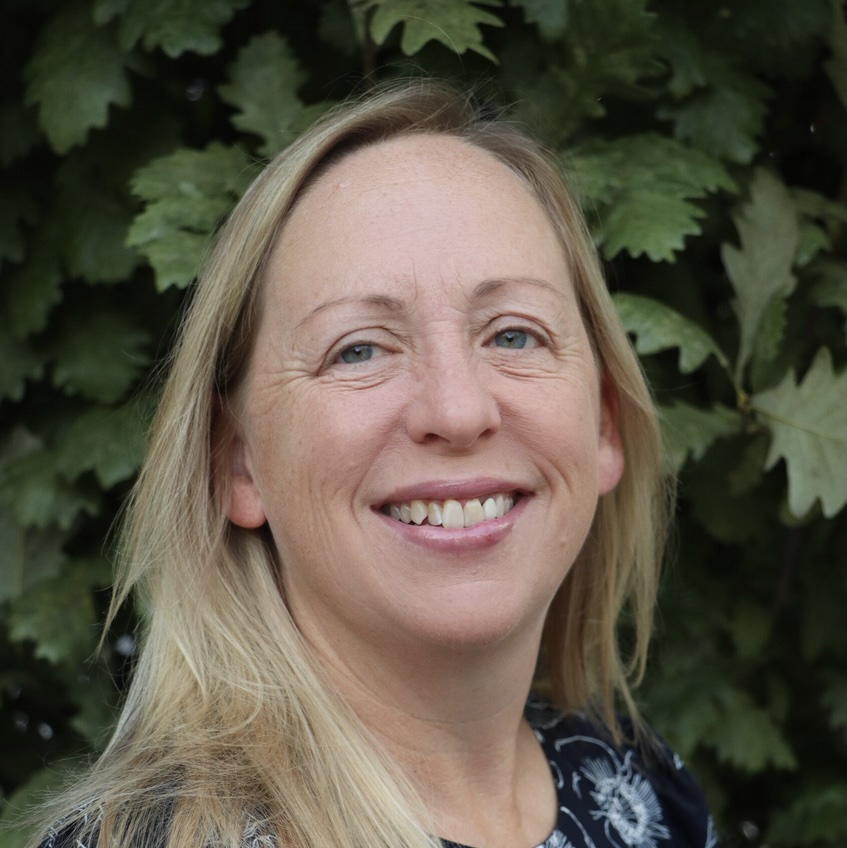
CMIOs are in a unique position. “We touch so many areas of healthcare delivery,” said Rebecca Mishuris, MD, CMIO at Mass General Brigham. “We get involved in everything from in-basket management to billing to actually delivering care.”
And because they’re straddling the clinician and user worlds, CMIOs have a unique perspective on how the tools and technologies that are being implemented at such a rapid pace are affecting the entire care delivery process.
That birdseye view has become extremely valuable when it comes to AI-driven tools like ambient listening, which has already demonstrated enormous potential for improving the experience for both providers and patients.
Recently, Mishuris and Natalie Pageler, MD, CMIO, Stanford Children’s Health, spoke with This Week Health about how ambient documentation is changing the game, and shared insights on how their teams are incorporating it into the practice while managing the unique challenges that have arisen.

Rebecca Mishuris, MD
Mishuris believes everyone should have a north star. For her team, it’s leveraging technology to deliver better care, and reducing clinician burnout.
And while there is certainly no silver bullet, ambient documentation comes pretty close by offering a “transformative way in which people are documenting and interacting with patients,” she said.
It’s not hyperbole. At Mass General Brigham, what started as a small pilot escalated quickly after the initial results were so positive. “What we found is that 80 percent of providers felt like they were paying more attention to their patients,” she recalled. “That’s gold – for the provider and the patient. The relationship with the provider changes when they’re able to look at you while you’re talking, rather than clacking away at a keyboard. Clearly, ambient documentation is here.”
The question, however, wasn’t about how it would be received, but rather, how it would integrate into existing workflows and impact users. And so, a decision was made to launch a 20-physician pilot and evaluate how ambient documentation handled different clinical settings and adjusted to situations like noisy emergency rooms or physicians speaking another language.
“We wanted to understand the impact on productivity, on revenue, and on risk,” Mishuris noted. “Did it work as well in primary care as it did in neurology? What about hallucinations? We had questions upon questions.”
Meanwhile, the response was so favorable that the pilot expanded exponentially, with MGB offering access to all physicians who wanted to participate. “It was clear that this was going to be transformative in terms of how clinicians interact with technology and with their patients,” she said, noting that more than 2,500 providers are currently using it, with requests continuing to roll in. “There’s a bit of a viral sensation to it.”
And while that has certainly been a positive, the rapid-fire adoption has also required leadership to take a radically different approach than with previous initiatives. “In healthcare, we tend to implement tried and true technologies,” she said, which isn’t the case with ambient listening tools. “This is a truly different space in terms of the speed with which the technology is developing and changing. We need a more nimble, innovative approach where we can quickly scale things that are continuing to evolve.”
Part of that is the communication strategy with users. Rather than presenting a fully-baked system, leaders find themselves saying, ‘here’s something that works really well. We know it doesn’t have all of the things you want. We’re actively working with the vendors. But we want your feedback. Try it out, and if you don’t like it, come back in six months because it might look pretty different,’” she said.
It represents a major shift from how things were done in the past, and that needs to be reflected in the messaging. “Changes are happening so quickly,” she noted. As a result, “having an open communication channel with users is really important.” Although some might respond to emails offering quick snippets of information, others prefer learning from super users. What’s important, however, is that the information is being absorbed, especially when it comes to responsible use of AI.
To that end, MGB has launched an education campaign explaining the limitations and guardrails around ChatGPT, and has established a secure lane for accessing large language models. “It’s the same thing we did in clinical informatics,” Mishuris said. “You can’t just tell someone not to do something. You have to make it easy for them to do the right thing. We’ve taken that approach in this space as well.”
And while it has required some adjustments, it’s been well worth the effort, she said, adding that 60 percent of providers said they were considering extending their clinical careers because of the benefits seen by ambient listening. “It’s so transformative. It’s a piece of technology that’s taking technology out of the way. “That’s super exciting to me.”

Natalie Pageler, MD
Like many forward-thinking organizations, Stanford Children’s is actively pursuing ways to improve patient care and increase efficiency by leveraging AI. “It’s an incredibly exciting time. The tools are developing quickly, and so, we’re really thinking about how we can make sure we’re providing continuous, proactive healthcare while being more effective and efficient with our resources,” said Pageler.
Being a pediatric facility, however, adds a few layers of complication, particularly when it comes to communicating with patients and families. “Our providers are being asked to do a lot,” she noted. “As we try to create ways to open access, we want to make sure they can focus on the patients and minimize the extra administrative burden.”
One way is through ambient scribe technology, which can assume some of the tasks that make it difficult to engage in face-to-face conversations. “If a provider doesn’t have to type and look at a computer, they can watch the interactions between the child and the family or watch the behaviors of the child,” Pageler said, which is particularly important when watching for signs of developmental delays. “We’re seeing some very exciting outcomes there.”
Despite the initial concern of how it would translate into the complex pediatric setting, in which there are often multiple caregivers involved, it has worked “incredibly well.” Providers in particular have reported feeling “more connected with the patient and family,” while patients have said providers are “more engaged and present.”
And it’s not just patient-facing tools that are having an impact, as Stanford has applied LLMs across different settings to provide “a better picture of patient safety and quality improvement work,” she stated.
One example is surgical site infections, which can be difficult to define due to the amount of data in free text form. Large language models can help screen the data, enabling team members to more quickly identify serious infections. Stanford is also using those models to comb through incident reports and find areas that might require intervention, she added. “That’s some really exciting work.”
Even more exciting is the use of machine learning to solve one of the biggest problems pediatric organizations face: engaging appropriately with adolescent and teenaged patients. After learning that more than half of those using teen portals were, in fact, guardians, Stanford
reset the portals, and began using natural language processing to double-check for accuracy. “That enables us to release all the non-confidential notes to the entire family, which is 99.9 percent of the notes,” Pageler added. “It’s really about how we can protect the small amount of confidential data so that we can get information to both the patient and the family.”
Doing so helps build a level of trust that enables physicians to ensure they’re getting proper care, while encouraging teens to be proactive and take ownership of their health, she added.
The portal has also made a difference for families of children with complex conditions, she noted. “We’ve gotten some incredible anecdotal feedback from parents about how being able to see all the notes from their different specialists helps them coordinate care and better understand it. That’s where we’re seeing really high rates of engagement.”
The complexities that arise with adolescent and teen patients – and how information is released – is just one of the key considerations of AI in the pediatric space, according to Pageler. Others include the variability across the age and size spectrum, the dearth of clinical information on pediatric patients (due to both smaller data sets and regulations), and the lack of algorithms and medications developed and tested specifically for pediatric patients.
Without those in place, it makes it extremely difficult to “safely, equitably, and meaningfully apply AI in this population,” she said. So what needs to happen? First and foremost, “we need the right decision makers at the table from the beginning to define the right questions for children and families, and to develop datasets that actually represent children across the spectrum. “We need data scientists, and we need to pair them with knowledgeable, thoughtful clinical informaticists who can help develop the right interventions and use those core clinical informatics principles to ensure that they are appropriately adopted and monitored and getting the right outcomes.”
And of course, it doesn’t stop there. Mishuris believes that ambient documentation will become “tablestakes,” and could eventually play a critical role in clinical decision support. “It knows the patient’s chart; it knows what we've talked about.
Could it also know the entire corpus of medical literature and help me decide what's the best medication to treat the blood pressure? Could it help make decisions better?” And while she believes humans will always play a critical role in providing care, she also projects that AI technologies can potentially make that care “safer and more effective,” provided the right steps are in place.
Pageler agreed, noting that ambient listening has already made a mark by freeing up physicians to “focus on the relationship part of medicine, which is what brings so much meaning in our everyday interactions.” For pediatric clinicians, “the idea of being able to set aside the computer and focus on the child and the family has really been empowering, and I think it will ultimately lead to better outcomes and happier providers and patients.”


Questions about the Podcast?
Contact us with any questions, requests, or comments about the show. We love hearing your feedback.

© Copyright 2024 Health Lyrics All rights reserved